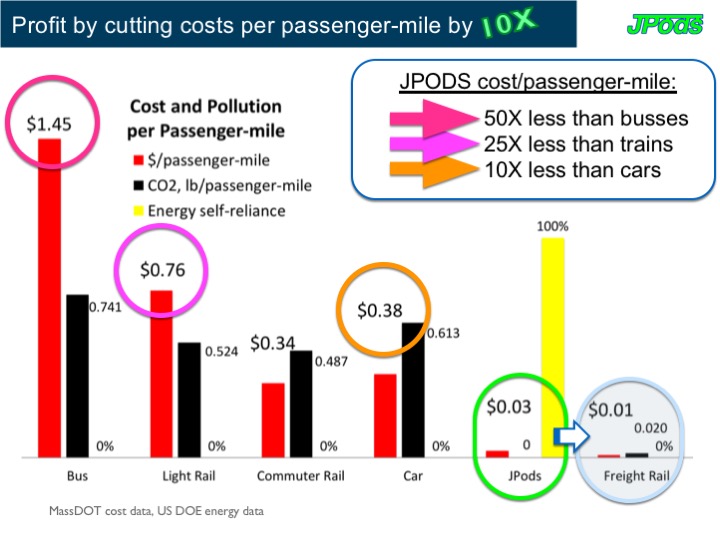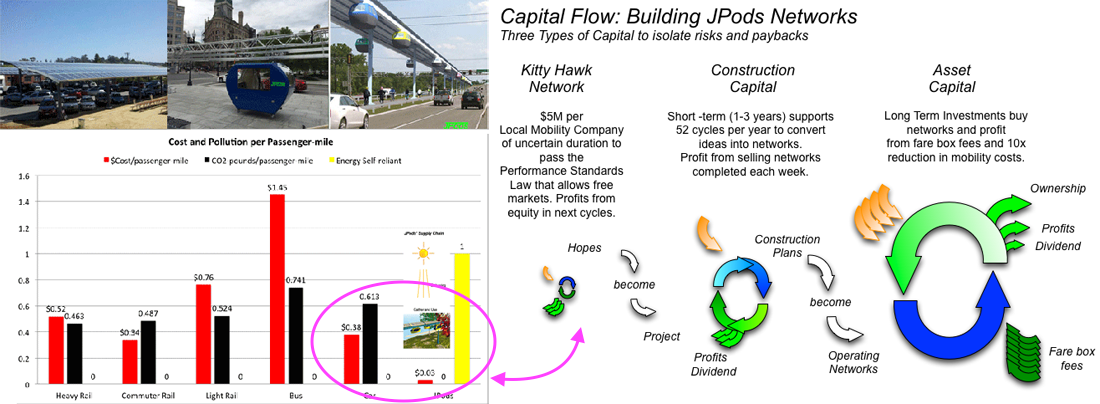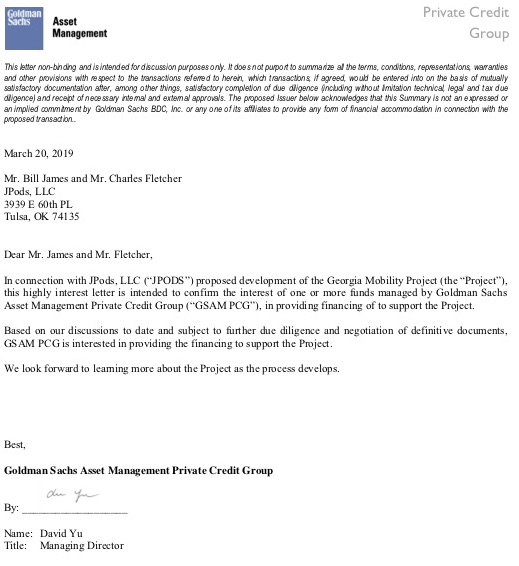Capital wants to invest in robotics:
- McKinsey and Company: ‘A physical version of the Internet’: How Hyperloop could be the broadband of transportation
- $28 billion was invested in mobility startups in 2017
- 40x ROI on Kiva’s $775 sale to Amazon
- Mar 5, 2020: Valued at $30bn, Waymo considers its next move "outside investors lined up this week to pour $2.25bn into Waymo"
Goldman Sachs provided JPods a Letter of Interest to invest $4-6 billion in JPods solar-powered mobilty networks under the 5x5 Standard.
Who pays for Building the JPods Network
JPods LLC pay to build our solar-powered mobility networks.
- We are investors, not vendors.
- We are taxpayers. We pay 5% of our gross revenues to use the public Rights of Way.
- We are investing in Georgia to provide solar-powered mobility networks that combine:
- JPods Networks are 10 times to 50 times less expensive per passenger-mile than cars and buses.

How can we fund $billions, Capital Flow:
Recorded for Arizona. The same framework as the Georgia Mobility Company
Because of a century of centrally plan infrastructure, it surprises Americans to think that infrastructure should be privately funded. But the building of the Internet and Transcontinental Railroads provide case studies in why infrastructure should be privately funded.
The book Great by Choice, Uncertainty, Chaos, and Luck - Why Some Thrive Despite Them All explains the processes required:
- "20-mile marching", incremental, steady, disciplined, step by step efforts.
- "Fire bullets, then cannonballs", tinkering by starting small and iterating relentlessly.
The book Nothing Like It in the World is a case study on how private capital-funded building the railroads. The following graphic illustrates three types of capital are used by two different types of companies:
- Local Mobility Companies® (LMCs) mission is to own and operate the JPods networks to meet local needs. LMCs have two tasks:
- Gain Rights of Way access (Solar Mobility Act and/or Franchise Contract with 5X5% Performance Standard)
- Profit by serving the farebox payers with greater value than the cost to compete.
- Master Mobility Companies® (MMCs) construct the networks defined by the LMCs. MMCs operate with very focused requirements:
- Repay construction capital every 12 months by selling completed networks to LMCs to operate.
- From survey to certification of rail should take no more than 9 months once the manufacturing base is ramped to scale.
- Complete 3 to 10 miles of networks per day per crew, matching the pace the Transcontinental Railroads were built in the 1860s.

Repeat the success of communications in power and transportation shift to standards-based regulations. Remove regulatory delays.
5X5 Standard provides the Rule of Law needed for capital to invest:
The 5X5 Standard provides a simple and effective way to create a stable regulatory environment so $billions will be invested in sustainable infrastructure.
- This standard applies to Networks 5 times more efficient than existing transport modes in a Right of Way.
- Construction of the Networks must be privately funded.
- Networks must operate without government subsidies.
- Networks pay 5% of gross revenues for non-exclusive use of Rights of Way, or what existing laws require of other infrastructure networks using public Rights of Ways.
- Aboveground Networks must gather at least 2 megawatt-hours of renewable energy per typical mile per typical day.
- In collaboration with the State government, a Web-based Document System (WDS) will be provided with secure access to all jurisdictions. Each Network Plan will be posted to the WDS. Plans not rejected in writing within 14 days are approved.
- The objective of this provision is to protect the interests of communities, remove bureaucratic delays, and remove problems coordinating with multiple agencies.
- This only applies to Networks 5 times more efficient than existing networks.
- Networks are regulated for safety by existing theme park regulations (typically ASTM F24).
- This provides a 50,000-times better standard than Federal DOT:
- 0.2 injuries per million using ASTM F24
- 11,200 injuries per million using Federal DOT regulations.
- This provides a 50,000-times better standard than Federal DOT:
Private capital has stated an interest to invest based on this 5X5 Standard.

